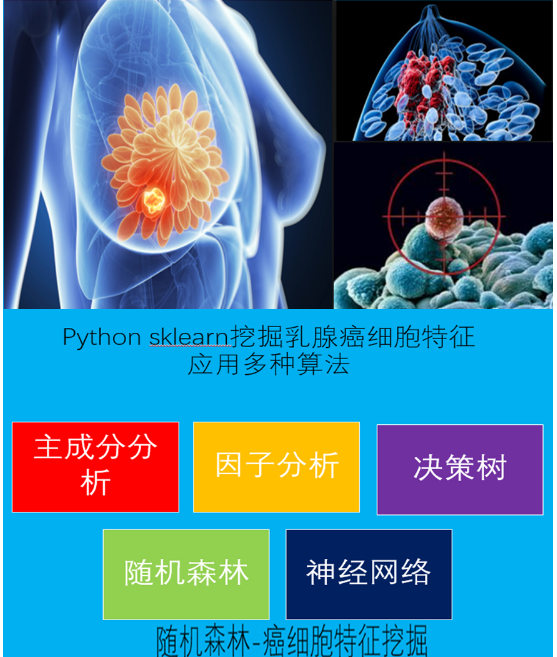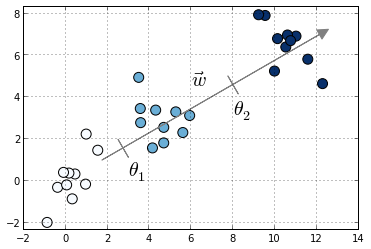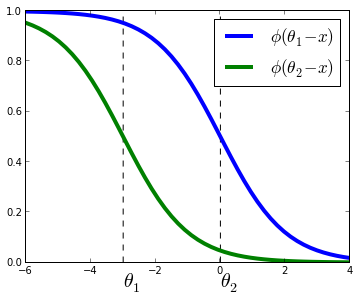Logistic Ordinal Regression
sklearn实战-乳腺癌细胞数据挖掘(博客主亲自录制视频教程)
https://study.163.com/course/introduction.htm?courseId=1005269003&utm_campaign=commission&utm_source=cp-400000000398149&utm_medium=share

数据统计分析项目联系QQ:231469242
http://fa.bianp.net/blog/2013/logistic-ordinal-regression/
# -*- coding: utf-8 -*-
"""
Created on Mon Jul 24 09:21:01 2017 @author: toby
""" # Import standard packages
import numpy as np # additional packages
from sklearn import metrics
from scipy import linalg, optimize, sparse
import warnings BIG = 1e10
SMALL = 1e-12 def phi(t):
''' logistic function, returns 1 / (1 + exp(-t)) ''' idx = t > 0
out = np.empty(t.size, dtype=np.float)
out[idx] = 1. / (1 + np.exp(-t[idx]))
exp_t = np.exp(t[~idx])
out[~idx] = exp_t / (1. + exp_t)
return out def log_logistic(t):
''' (minus) logistic loss function, returns log(1 / (1 + exp(-t))) ''' idx = t > 0
out = np.zeros_like(t)
out[idx] = np.log(1 + np.exp(-t[idx]))
out[~idx] = (-t[~idx] + np.log(1 + np.exp(t[~idx])))
return out def ordinal_logistic_fit(X, y, alpha=0, l1_ratio=0, n_class=None, max_iter=10000,
verbose=False, solver='TNC', w0=None):
'''
Ordinal logistic regression or proportional odds model.
Uses scipy's optimize.fmin_slsqp solver. Parameters
----------
X : {array, sparse matrix}, shape (n_samples, n_feaures)
Input data
y : array-like
Target values
max_iter : int
Maximum number of iterations
verbose: bool
Print convergence information Returns
-------
w : array, shape (n_features,)
coefficients of the linear model
theta : array, shape (k,), where k is the different values of y
vector of thresholds
''' X = np.asarray(X)
y = np.asarray(y)
w0 = None if not X.shape[0] == y.shape[0]:
raise ValueError('Wrong shape for X and y') # .. order input ..
idx = np.argsort(y)
idx_inv = np.zeros_like(idx)
idx_inv[idx] = np.arange(idx.size)
X = X[idx]
y = y[idx].astype(np.int)
# make them continuous and start at zero
unique_y = np.unique(y)
for i, u in enumerate(unique_y):
y[y == u] = i
unique_y = np.unique(y) # .. utility arrays used in f_grad ..
alpha = 0.
k1 = np.sum(y == unique_y[0])
E0 = (y[:, np.newaxis] == np.unique(y)).astype(np.int)
E1 = np.roll(E0, -1, axis=-1)
E1[:, -1] = 0.
E0, E1 = map(sparse.csr_matrix, (E0.T, E1.T)) def f_obj(x0, X, y):
"""
Objective function
"""
w, theta_0 = np.split(x0, [X.shape[1]])
theta_1 = np.roll(theta_0, 1)
t0 = theta_0[y]
z = np.diff(theta_0) Xw = X.dot(w)
a = t0 - Xw
b = t0[k1:] - X[k1:].dot(w)
c = (theta_1 - theta_0)[y][k1:] if np.any(c > 0):
return BIG #loss = -(c[idx] + np.log(np.exp(-c[idx]) - 1)).sum()
loss = -np.log(1 - np.exp(c)).sum() loss += b.sum() + log_logistic(b).sum() \
+ log_logistic(a).sum() \
+ .5 * alpha * w.dot(w) - np.log(z).sum() # penalty
if np.isnan(loss):
pass
#import ipdb; ipdb.set_trace()
return loss def f_grad(x0, X, y):
"""
Gradient of the objective function
"""
w, theta_0 = np.split(x0, [X.shape[1]])
theta_1 = np.roll(theta_0, 1)
t0 = theta_0[y]
t1 = theta_1[y]
z = np.diff(theta_0) Xw = X.dot(w)
a = t0 - Xw
b = t0[k1:] - X[k1:].dot(w)
c = (theta_1 - theta_0)[y][k1:] # gradient for w
phi_a = phi(a)
phi_b = phi(b)
grad_w = -X[k1:].T.dot(phi_b) + X.T.dot(1 - phi_a) + alpha * w # gradient for theta
idx = c > 0
tmp = np.empty_like(c)
tmp[idx] = 1. / (np.exp(-c[idx]) - 1)
tmp[~idx] = np.exp(c[~idx]) / (1 - np.exp(c[~idx])) # should not need
grad_theta = (E1 - E0)[:, k1:].dot(tmp) \
+ E0[:, k1:].dot(phi_b) - E0.dot(1 - phi_a) grad_theta[:-1] += 1. / np.diff(theta_0)
grad_theta[1:] -= 1. / np.diff(theta_0)
out = np.concatenate((grad_w, grad_theta))
return out def f_hess(x0, s, X, y):
x0 = np.asarray(x0)
w, theta_0 = np.split(x0, [X.shape[1]])
theta_1 = np.roll(theta_0, 1)
t0 = theta_0[y]
t1 = theta_1[y]
z = np.diff(theta_0) Xw = X.dot(w)
a = t0 - Xw
b = t0[k1:] - X[k1:].dot(w)
c = (theta_1 - theta_0)[y][k1:] D = np.diag(phi(a) * (1 - phi(a)))
D_= np.diag(phi(b) * (1 - phi(b)))
D1 = np.diag(np.exp(-c) / (np.exp(-c) - 1) ** 2)
Ex = (E1 - E0)[:, k1:].toarray()
Ex0 = E0.toarray()
H_A = X[k1:].T.dot(D_).dot(X[k1:]) + X.T.dot(D).dot(X)
H_C = - X[k1:].T.dot(D_).dot(E0[:, k1:].T.toarray()) \
- X.T.dot(D).dot(E0.T.toarray())
H_B = Ex.dot(D1).dot(Ex.T) + Ex0[:, k1:].dot(D_).dot(Ex0[:, k1:].T) \
- Ex0.dot(D).dot(Ex0.T) p_w = H_A.shape[0]
tmp0 = H_A.dot(s[:p_w]) + H_C.dot(s[p_w:])
tmp1 = H_C.T.dot(s[:p_w]) + H_B.dot(s[p_w:])
return np.concatenate((tmp0, tmp1)) import ipdb; ipdb.set_trace()
import pylab as pl
pl.matshow(H_B)
pl.colorbar()
pl.title('True')
import numdifftools as nd
Hess = nd.Hessian(lambda x: f_obj(x, X, y))
H = Hess(x0)
pl.matshow(H[H_A.shape[0]:, H_A.shape[0]:])
#pl.matshow()
pl.title('estimated')
pl.colorbar()
pl.show() def grad_hess(x0, X, y):
grad = f_grad(x0, X, y)
hess = lambda x: f_hess(x0, x, X, y)
return grad, hess x0 = np.random.randn(X.shape[1] + unique_y.size) / X.shape[1]
if w0 is not None:
x0[:X.shape[1]] = w0
else:
x0[:X.shape[1]] = 0.
x0[X.shape[1]:] = np.sort(unique_y.size * np.random.rand(unique_y.size)) #print('Check grad: %s' % optimize.check_grad(f_obj, f_grad, x0, X, y))
#print(optimize.approx_fprime(x0, f_obj, 1e-6, X, y))
#print(f_grad(x0, X, y))
#print(optimize.approx_fprime(x0, f_obj, 1e-6, X, y) - f_grad(x0, X, y))
#import ipdb; ipdb.set_trace() def callback(x0):
x0 = np.asarray(x0)
# print('Check grad: %s' % optimize.check_grad(f_obj, f_grad, x0, X, y))
if verbose:
# check that gradient is correctly computed
print('OBJ: %s' % f_obj(x0, X, y)) if solver == 'TRON':
import pytron
out = pytron.minimize(f_obj, grad_hess, x0, args=(X, y))
else:
options = {'maxiter' : max_iter, 'disp': 0, 'maxfun':10000}
out = optimize.minimize(f_obj, x0, args=(X, y), method=solver,
jac=f_grad, hessp=f_hess, options=options, callback=callback) if not out.success:
warnings.warn(out.message)
w, theta = np.split(out.x, [X.shape[1]])
return w, theta def ordinal_logistic_predict(w, theta, X):
"""
Parameters
----------
w : coefficients obtained by ordinal_logistic
theta : thresholds
"""
unique_theta = np.sort(np.unique(theta))
out = X.dot(w)
unique_theta[-1] = np.inf # p(y <= max_level) = 1
tmp = out[:, None].repeat(unique_theta.size, axis=1)
return np.argmax(tmp < unique_theta, axis=1) def main():
DOC = """
================================================================================
Compare the prediction accuracy of different models on the boston dataset
================================================================================
"""
print(DOC)
from sklearn import cross_validation, datasets
boston = datasets.load_boston()
X, y = boston.data, np.round(boston.target)
#X -= X.mean()
y -= y.min() idx = np.argsort(y)
X = X[idx]
y = y[idx]
cv = cross_validation.ShuffleSplit(y.size, n_iter=50, test_size=.1, random_state=0)
score_logistic = []
score_ordinal_logistic = []
score_ridge = []
for i, (train, test) in enumerate(cv):
#test = train
if not np.all(np.unique(y[train]) == np.unique(y)):
# we need the train set to have all different classes
continue
assert np.all(np.unique(y[train]) == np.unique(y))
train = np.sort(train)
test = np.sort(test)
w, theta = ordinal_logistic_fit(X[train], y[train], verbose=True,
solver='TNC')
pred = ordinal_logistic_predict(w, theta, X[test])
s = metrics.mean_absolute_error(y[test], pred)
print('ERROR (ORDINAL) fold %s: %s' % (i+1, s))
score_ordinal_logistic.append(s) from sklearn import linear_model
clf = linear_model.LogisticRegression(C=1.)
clf.fit(X[train], y[train])
pred = clf.predict(X[test])
s = metrics.mean_absolute_error(y[test], pred)
print('ERROR (LOGISTIC) fold %s: %s' % (i+1, s))
score_logistic.append(s) from sklearn import linear_model
clf = linear_model.Ridge(alpha=1.)
clf.fit(X[train], y[train])
pred = np.round(clf.predict(X[test]))
s = metrics.mean_absolute_error(y[test], pred)
print('ERROR (RIDGE) fold %s: %s' % (i+1, s))
score_ridge.append(s) print()
print('MEAN ABSOLUTE ERROR (ORDINAL LOGISTIC): %s' % np.mean(score_ordinal_logistic))
print('MEAN ABSOLUTE ERROR (LOGISTIC REGRESSION): %s' % np.mean(score_logistic))
print('MEAN ABSOLUTE ERROR (RIDGE REGRESSION): %s' % np.mean(score_ridge))
# print('Chance level is at %s' % (1. / np.unique(y).size)) return np.mean(score_ridge) if __name__ == '__main__':
out = main()
print(out)
TL;DR: I've implemented a logistic ordinal regression or proportional odds model. Here is the Python code
The logistic ordinal regression model, also known as the proportional odds was introduced in the early 80s by McCullagh [1, 2] and is a generalized linear model specially tailored for the case of predicting ordinal variables, that is, variables that are discrete (as in classification) but which can be ordered (as in regression). It can be seen as an extension of the logistic regression model to the ordinal setting.
Given X∈Rn×pX∈Rn×p input data and y∈Nny∈Nn target values. For simplicity we assume yy is a non-decreasing vector, that is, y1≤y2≤...y1≤y2≤.... Just as the logistic regression models posterior probability P(y=j|Xi)P(y=j|Xi) as the logistic function, in the logistic ordinal regression we model thecummulative probability as the logistic function. That is,
P(y≤j|Xi)=ϕ(θj−wTXi)=11+exp(wTXi−θj)P(y≤j|Xi)=ϕ(θj−wTXi)=11+exp(wTXi−θj)
where w,θw,θ are vectors to be estimated from the data and ϕϕ is the logistic function defined as ϕ(t)=1/(1+exp(−t))ϕ(t)=1/(1+exp(−t)).

 Toy example with three classes denoted in different colors. Also shown the vector of coefficients ww and the thresholds θ0θ0 and θ1θ1
Toy example with three classes denoted in different colors. Also shown the vector of coefficients ww and the thresholds θ0θ0 and θ1θ1
Compared to multiclass logistic regression, we have added the constrain that the hyperplanes that separate the different classes are parallel for all classes, that is, the vector ww is common across classes. To decide to which class will XiXi be predicted we make use of the vector of thresholds θθ. If there are KK different classes, θθ is a non-decreasing vector (that is, θ1≤θ2≤...≤θK−1θ1≤θ2≤...≤θK−1) of size K−1K−1. We will then assign the class jj if the prediction wTXwTX (recall that it's a linear model) lies in the interval [θj−1,θj[[θj−1,θj[. In order to keep the same definition for extremal classes, we define θ0=−∞θ0=−∞ and θK=+∞θK=+∞.
The intuition is that we are seeking a vector ww such that XwXw produces a set of values that are well separated into the different classes by the different thresholds θθ. We choose a logistic function to model the probability P(y≤j|Xi)P(y≤j|Xi) but other choices are possible. In the proportional hazards model 1 the probability is modeled as −log(1−P(y≤j|Xi))=exp(θj−wTXi)−log(1−P(y≤j|Xi))=exp(θj−wTXi). Other link functions are possible, where the link function satisfies link(P(y≤j|Xi))=θj−wTXilink(P(y≤j|Xi))=θj−wTXi. Under this framework, the logistic ordinal regression model has a logistic link function and the proportional hazards model has a log-log link function.
The logistic ordinal regression model is also known as the proportional odds model, because the ratio of corresponding odds for two different samples X1X1 and X2X2 is exp(wT(X1−X2))exp(wT(X1−X2)) and so does not depend on the class jj but only on the difference between the samples X1X1 and X2X2.
Optimization
Model estimation can be posed as an optimization problem. Here, we minimize the loss function for the model, defined as minus the log-likelihood:
L(w,θ)=−n∑i=1log(ϕ(θyi−wTXi)−ϕ(θyi−1−wTXi))L(w,θ)=−∑i=1nlog(ϕ(θyi−wTXi)−ϕ(θyi−1−wTXi))
In this sum all terms are convex on ww, thus the loss function is convex over ww. It might be also jointly convex over ww and θθ, although I haven't checked. I use the function fmin_slsqp in scipy.optimize to optimize LLunder the constraint that θθ is a non-decreasing vector. There might be better options, I don't know. If you do know, please leave a comment!.
Using the formula log(ϕ(t))′=(1−ϕ(t))log(ϕ(t))′=(1−ϕ(t)), we can compute the gradient of the loss function as
∇wL(w,θ)=n∑i=1Xi(1−ϕ(θyi−wTXi)−ϕ(θyi−1−wTXi))∇θL(w,θ)=n∑i=1eyi(1−ϕ(θyi−wTXi)−11−exp(θyi−1−θyi))+eyi−1(1−ϕ(θyi−1−wTXi)−11−exp(−(θyi−1−θyi)))∇wL(w,θ)=∑i=1nXi(1−ϕ(θyi−wTXi)−ϕ(θyi−1−wTXi))∇θL(w,θ)=∑i=1neyi(1−ϕ(θyi−wTXi)−11−exp(θyi−1−θyi))+eyi−1(1−ϕ(θyi−1−wTXi)−11−exp(−(θyi−1−θyi)))
where eiei is the iith canonical vector.
Code
I've implemented a Python version of this algorithm using Scipy'soptimize.fmin_slsqp function. This takes as arguments the loss function, the gradient denoted before and a function that is > 0 when the inequalities on θθ are satisfied.
Code can be found here as part of the minirank package, which is my sandbox for code related to ranking and ordinal regression. At some point I would like to submit it to scikit-learn but right now the I don't know how the code will scale to medium-scale problems, but I suspect not great. On top of that I'm not sure if there is a real demand of these models for scikit-learn and I don't want to bloat the package with unused features.
Performance
I compared the prediction accuracy of this model in the sense of mean absolute error (IPython notebook) on the boston house-prices dataset. To have an ordinal variable, I rounded the values to the closest integer, which gave me a problem of size 506 ×× 13 with 46 different target values. Although not a huge increase in accuracy, this model did give me better results on this particular dataset:

Here, ordinal logistic regression is the best-performing model, followed by a Linear Regression model and a One-versus-All Logistic regression model as implemented in scikit-learn.
python风控评分卡建模和风控常识(博客主亲自录制视频教程)
Logistic Ordinal Regression的更多相关文章
- Logistic/Softmax Regression
辅助函数 牛顿法介绍 %% Logistic Regression close all clear %%load data x = load('ex4x.dat'); y = load('ex4y.d ...
- LOGIT REGRESSION
Version info: Code for this page was tested in SPSS 20. Logistic regression, also called a logit mod ...
- spss
编辑 SPSS(Statistical Product and Service Solutions),“统计产品与服务解决方案”软件.最初软件全称为“社会科学统计软件包” (SolutionsStat ...
- 2016CVPR论文集
http://www.cv-foundation.org/openaccess/CVPR2016.py ORAL SESSION Image Captioning and Question Answe ...
- HAWQ + MADlib 玩转数据挖掘之(一)——安装
一.MADlib简介 MADlib是Pivotal公司与伯克利大学合作的一个开源机器学习库,提供了精确的数据并行实现.统计和机器学习方法对结构化和非结构化数据进行分析,主要目的是扩展数据库的分析能力, ...
- 用SQL玩转数据挖掘之MADlib(一)——安装
一.MADlib简介 MADlib是Pivotal公司与伯克利大学合作的一个开源机器学习库,提供了精确的数据并行实现.统计和机器学习方法对结构化和非结构化数据进行分析,主要目的是扩展数据库的分析能力, ...
- CVPR2016 Paper list
CVPR2016 Paper list ORAL SESSIONImage Captioning and Question Answering Monday, June 27th, 9:00AM - ...
- SPSS统计分析过程包括描述性统计、均值比较、一般线性模型、相关分析、回归分析、对数线性模型、聚类分析、数据简化、生存分析、时间序列分析、多重响应等几大类
https://www.zhihu.com/topic/19582125/top-answershttps://wenku.baidu.com/search?word=spss&ie=utf- ...
- [Machine Learning] Learning to rank算法简介
声明:以下内容根据潘的博客和crackcell's dustbin进行整理,尊重原著,向两位作者致谢! 1 现有的排序模型 排序(Ranking)一直是信息检索的核心研究问题,有大量的成熟的方法,主要 ...
随机推荐
- Daily Srum 10.21
到目前为止,我们组处在学习阶段,很多知识点都还不太清楚,所以现在我们还在看相关书籍和博客,任务. 而我们此间主要是在阅读一些材料: 陈谋一直在看学长的代码,其中C#的很多方式我都不太明白(尽管和Jav ...
- [2019BUAA软工]第0次代码作业
Visual Studio 单元测试的简单应用 写在前面 笔者根据作业的介绍以及Visual Studio 2017 文档的相关说明,进行了Visual Studio 单元测试的简单应用. Tip ...
- Python学习二
list [ ] Python内置的一种数据类型是列表:list.list是一种有序的集合,可以随时添加和删除其中的元素 classmates = ['Michael', 'Bob', 'Tracy ...
- C++:构造函数3——浅拷贝和深拷贝
一.默认拷贝构造函数 拷贝构造函数是一种特殊的构造函数(详情见:http://www.cnblogs.com/duwenxing/p/7429777.html),如果用户在定义类时没有显式地编写拷贝构 ...
- 《Spring1之第六次站立会议》
<第六次站立会议> 昨天:向小伙伴们请教了我代码的错误的解决方法以及对TCP/IP协议进行了相关的了解. 今天:我把自己项目工程里的服务器端界面进行了优化和完善. 遇到的问题:觉得做的界面 ...
- Leetcode题库——27.移除元素
@author: ZZQ @software: PyCharm @file: removeElement.py @time: 2018/9/23 14:04 要求:给定一个数组 nums 和一个值 v ...
- bootstrap使用总结
bootstrap是一个webcss框架,集合了html/css/jquery为一家,创建响应式的页面.所谓的响应式就是适配不同的上网设备. 使用bootstrap的步骤: 1.下载bootstrap ...
- angularJS1笔记-(15)-自定义指令(accordion伸缩菜单原始实现)
index.html: <!DOCTYPE html> <html lang="en"> <head> <meta charset=&qu ...
- Activity设置背景透明之开发坑
Activity设置背景透明的常规方法 方法一.在Manifest.xml中,直接在需要设置的Activity中添加主题样式: Android:theme="@android:style/T ...
- 软工网络15团队作业8——Beta阶段敏捷冲刺(用户使用调查报告)
一.项目概述 1.项目名称 考研必背 2.项目简介 微信小程序,帮助考研学生记忆单词. 3.项目预期达到目标 用户无需下载app,仅通过微信小程序就可以达到背单词的目的,并且能够制定背单词的计划. 4 ...

